The Snow and The Shining
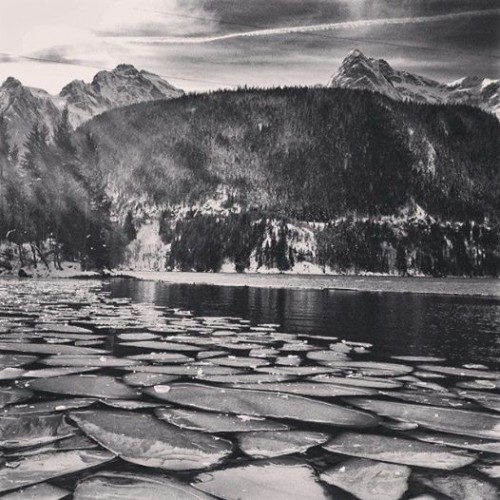
A small avalanche across Highway 20 just east of Newhalem at milepost 121 had residents of the Environmental Learning Center stuck at home Monday morning through Thursday morning of this week. The Washington State Department of Transportation (WSDOT) was waiting until avalanche danger had decreased to assess the situation and clear the snow and debris. The highway is now passable up to its regular winter closure at milepost 134, seven miles east of Diablo Dam.
What did the closure mean for life at the Learning Center? Graduate students couldn’t leave, and staff who live down valley in Newhalem and Marblemount couldn’t come up. Residents had to increase their awareness of their daily actions, since they already live at a remote facility (defined as 60 miles or more from definitive medical care) and now had even fewer options for help if need be. But by far the worst consequence was the cancellation of Mountain School. Two Bellingham elementary schools, Wade King and Northern Heights, could not spend their three days exploring ecosystems in the North Cascades as planned. The avalanche was the second time this school year that both schools thought they were coming but were prevented by outside forces (the first was during the government shut-down last October). They are troopers! Both have been rescheduled.
During this time, Senior Naturalist Kevin Biggs could not get to work from Marblemount for two days, but was offered the opportunity on Wednesday to be take the extra seat of the Seattle City Light helicopter and be flown up to participate in trainings. Here are a few aerial photos from his exciting journey.
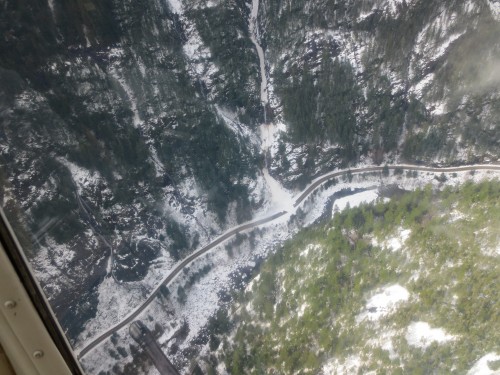 The avalanche on Highway 20, milepost 121. Photo by Kevin Biggs.
The avalanche on Highway 20, milepost 121. Photo by Kevin Biggs.
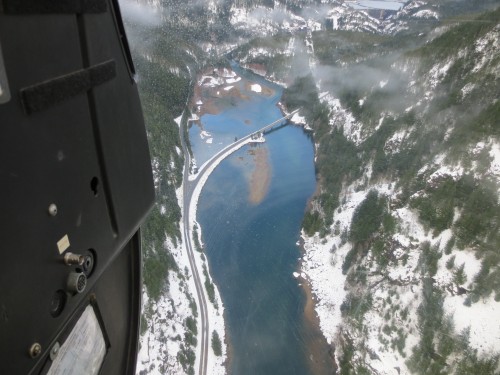 Gorge Lake and the town of Diablo. Photo by Kevin Biggs.
Gorge Lake and the town of Diablo. Photo by Kevin Biggs.
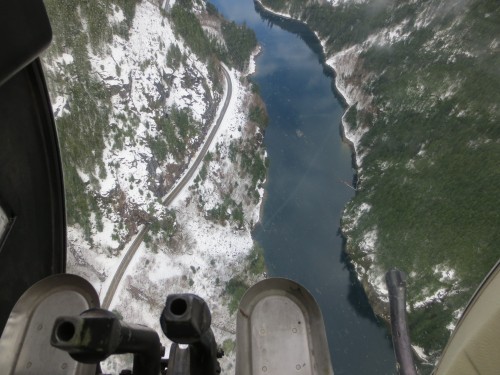 Above one of the tunnels on Highway 20 between Newhalem and Diablo. Photo by Kevin Biggs.
Above one of the tunnels on Highway 20 between Newhalem and Diablo. Photo by Kevin Biggs.
The resident graduate students chose to make the best of the snowed-in situation and efficiently cross two things off their “Wintertime To-Do List” simultaneously: “Make a Blanket Fort” and “Watch The Shining”. Raiding both their backpacking supplies and the office, they constructed a fort in the Wild Ginger Library by stringing up tapestries and sheets with parachute chord and industrial strength binder clips.
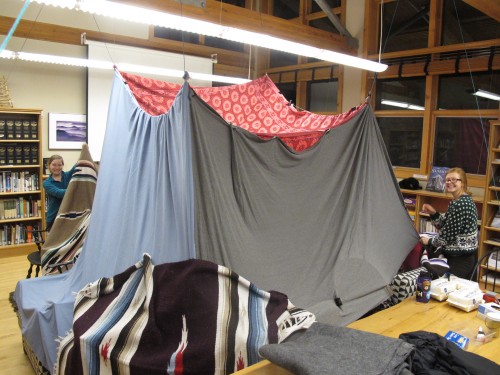 Tyler Chisholm and Katie Komorowski put their construction and interior design skills to use on a recent dark and stormy night. Photo by Katherine Renz.
Tyler Chisholm and Katie Komorowski put their construction and interior design skills to use on a recent dark and stormy night. Photo by Katherine Renz.
And really, as practicing environmental educators the grads were simply exemplifying one of the seven “Children and Nature Design Principles” as described by award-winning author and educator David Sobel in his book, Childhood and Nature: Design Principles for Educators. Among principles such as “Animal Allies” and “Hunting and Gathering” is “Special Places”: “[There] appears to be a universal tendency for children to create or find their own private places,” Sobel writes. “I believe the creation of these places serves many developmental purposes for children. The fort is a home away from home in nature; it provides a bridge between the safe, protected world of the family and the independent self in the wider world of adolescence. These places also serve as vehicles of bonding with the natural world, allowing children to feel comfortable in the landscape, connected to it, and eventually committed to acting as stewards of it.”
So, really, the blanket fort was an exercise in preparation for facilitating the next generation of ecological stewards.
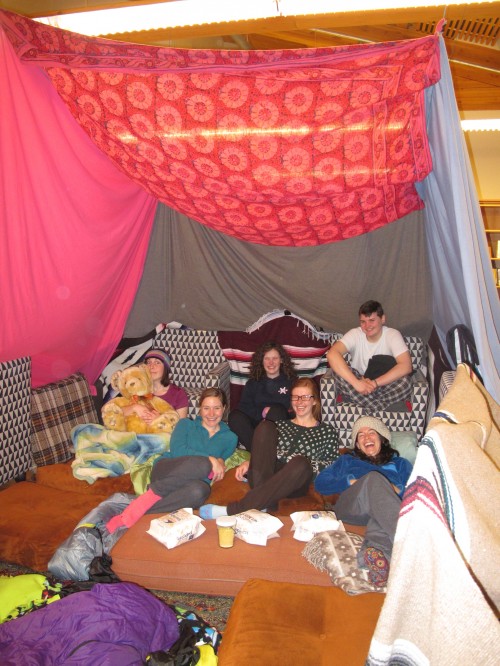 All smiles, bright lights, three bags of popcorn and a jar of nutritional yeast. This is before the film. Photo by Katherine Renz.
All smiles, bright lights, three bags of popcorn and a jar of nutritional yeast. This is before the film. Photo by Katherine Renz.
With each cushion and sleeping bag of the Special Place Blanket Fort in order, it was time to watch Stanley Kubrick’s 1980 screen version of Steven King’s psychological horror novel, The Shining (1977), a feature film we had been planning on watching during a snowstorm since we’d moved to the isolated Environmental Learning Center way back in the sunny days of September. This activity also be considered related to our studies, in multiple ways: it taught us how not to act when you’re stuck in the mountains with a lot of writing to do; it showed us one of our sister Cascade peaks, Oregon’s Mount Hood, which towered over the backdrop for the exterior shots of the movie’s haunted Overlook Hotel, known in real life is called the Timberline Hotel, a National Historic Landmark built in the late 1930s; and it encouraged further cohort bonding, as any good horror movie will do.
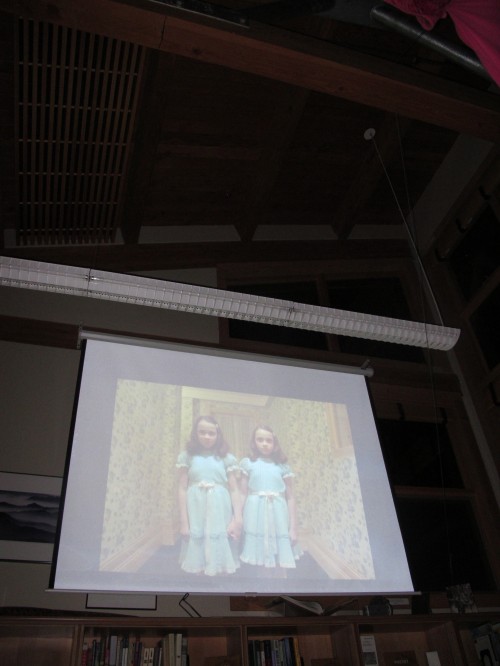 “Come and play with us, forever, and ever, and ever……”. The creepy ghost sisters of The Shining, as seen in the Wild Ginger Library-cum-independent movie house. Photo by Katherine Renz.
“Come and play with us, forever, and ever, and ever……”. The creepy ghost sisters of The Shining, as seen in the Wild Ginger Library-cum-independent movie house. Photo by Katherine Renz.
The road is open, the snow is slowly melting, and the grads have transitioned from fort-building to prepping lesson plans. We look forward to Mountain School resuming next week and watching the landscape morph, day by day, in to spring.
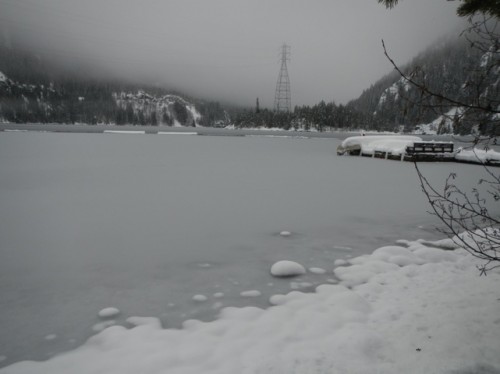 Diablo Lake from the shore at the Environmental Learning Center, Monday morning. Program Manager Katie Roloson said this was the first time she had ever seen the lake so completely covered in slush. It’s almost hard to imagine it having its characteristicly jewel-green, milky blue summertime hue. Photo by Katie Roloson.
Diablo Lake from the shore at the Environmental Learning Center, Monday morning. Program Manager Katie Roloson said this was the first time she had ever seen the lake so completely covered in slush. It’s almost hard to imagine it having its characteristicly jewel-green, milky blue summertime hue. Photo by Katie Roloson.
Leading photo: Chunks of ice float on Diablo Lake in the shadow of Colonial and Pyramid Peaks on the weekend preceding Monday’s avalanche. Photo by Katie Komorowski.
Katherine Renz is a graduate student in North Cascades Institute and Western Washington University’s M.Ed. program and co-editor of Chattermarks. She is happy to say that The Shining is less terrifying by the third viewing.

